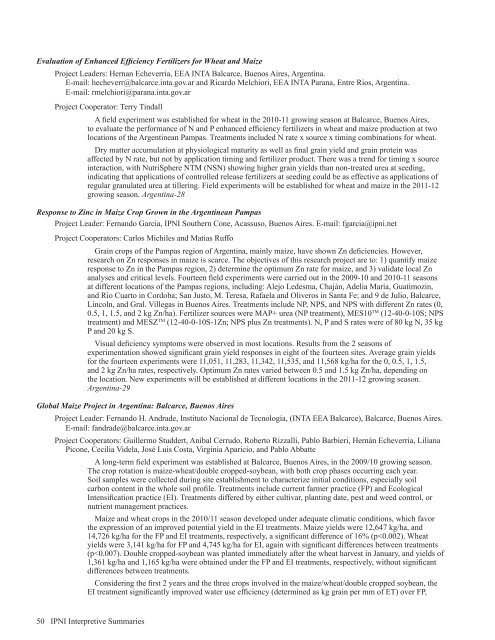Americas and Oceania Group - International Plant Nutrition Institute
Americas and Oceania Group - International Plant Nutrition Institute
Americas and Oceania Group - International Plant Nutrition Institute
You also want an ePaper? Increase the reach of your titles
YUMPU automatically turns print PDFs into web optimized ePapers that Google loves.
Evaluation of Enhanced Efficiency Fertilizers for Wheat <strong>and</strong> Maize<br />
Project Leaders: Hernan Echeverria, EEA INTA Balcarce, Buenos Aires, Argentina.<br />
E-mail: hecheverr@balcarce.inta.gov.ar <strong>and</strong> Ricardo Melchiori, EEA INTA Parana, Entre Rios, Argentina.<br />
E-mail: rmelchiori@parana.inta.gov.ar<br />
Project Cooperator: Terry Tindall<br />
A field experiment was established for wheat in the 2010-11 growing season at Balcarce, Buenos Aires,<br />
to evaluate the performance of N <strong>and</strong> P enhanced efficiency fertilizers in wheat <strong>and</strong> maize production at two<br />
locations of the Argentinean Pampas. Treatments included N rate x source x timing combinations for wheat.<br />
Dry matter accumulation at physiological maturity as well as final grain yield <strong>and</strong> grain protein was<br />
affected by N rate, but not by application timing <strong>and</strong> fertilizer product. There was a trend for timing x source<br />
interaction, with NutriSphere NTM (NSN) showing higher grain yields than non-treated urea at seeding,<br />
indicating that applications of controlled release fertilizers at seeding could be as effective as applications of<br />
regular granulated urea at tillering. Field experiments will be established for wheat <strong>and</strong> maize in the 2011-12<br />
growing season. Argentina-28<br />
Response to Zinc in Maize Crop Grown in the Argentinean Pampas<br />
Project Leader: Fern<strong>and</strong>o Garcia, IPNI Southern Cone, Acassuso, Buenos Aires. E-mail: fgarcia@ipni.net<br />
Project Cooperators: Carlos Michiles <strong>and</strong> Matias Ruffo<br />
Grain crops of the Pampas region of Argentina, mainly maize, have shown Zn deficiencies. However,<br />
research on Zn responses in maize is scarce. The objectives of this research project are to: 1) quantify maize<br />
response to Zn in the Pampas region, 2) determine the optimum Zn rate for maize, <strong>and</strong> 3) validate local Zn<br />
analyses <strong>and</strong> critical levels. Fourteen field experiments were carried out in the 2009-10 <strong>and</strong> 2010-11 seasons<br />
at different locations of the Pampas regions, including: Alejo Ledesma, Chaján, Adelia María, Guatimozin,<br />
<strong>and</strong> Rio Cuarto in Cordoba; San Justo, M. Teresa, Rafaela <strong>and</strong> Oliveros in Santa Fe; <strong>and</strong> 9 de Julio, Balcarce,<br />
Lincoln, <strong>and</strong> Gral. Villegas in Buenos Aires. Treatments include NP, NPS, <strong>and</strong> NPS with different Zn rates (0,<br />
0.5, 1, 1.5, <strong>and</strong> 2 kg Zn/ha). Fertilizer sources were MAP+ urea (NP treatment), MES10 TM (12-40-0-10S; NPS<br />
treatment) <strong>and</strong> MESZ TM (12-40-0-10S-1Zn; NPS plus Zn treatments). N, P <strong>and</strong> S rates were of 80 kg N, 35 kg<br />
P <strong>and</strong> 20 kg S.<br />
Visual deficiency symptoms were observed in most locations. Results from the 2 seasons of<br />
experimentation showed significant grain yield responses in eight of the fourteen sites. Average grain yields<br />
for the fourteen experiments were 11,051, 11,283, 11,342, 11,535, <strong>and</strong> 11,568 kg/ha for the 0, 0.5, 1, 1.5,<br />
<strong>and</strong> 2 kg Zn/ha rates, respectively. Optimum Zn rates varied between 0.5 <strong>and</strong> 1.5 kg Zn/ha, depending on<br />
the location. New experiments will be established at different locations in the 2011-12 growing season.<br />
Argentina-29<br />
Global Maize Project in Argentina: Balcarce, Buenos Aires<br />
Project Leader: Fern<strong>and</strong>o H. Andrade, Instituto Nacional de Tecnología, (INTA EEA Balcarce), Balcarce, Buenos Aires.<br />
E-mail: f<strong>and</strong>rade@balcarce.inta.gov.ar<br />
Project Cooperators: Guillermo Studdert, Aníbal Cerrudo, Roberto Rizzalli, Pablo Barbieri, Hernán Echeverria, Liliana<br />
Picone, Cecilia Videla, José Luis Costa, Virginia Aparicio, <strong>and</strong> Pablo Abbatte<br />
A long-term field experiment was established at Balcarce, Buenos Aires, in the 2009/10 growing season.<br />
The crop rotation is maize-wheat/double cropped-soybean, with both crop phases occurring each year.<br />
Soil samples were collected during site establishment to characterize initial conditions, especially soil<br />
carbon content in the whole soil profile. Treatments include current farmer practice (FP) <strong>and</strong> Ecological<br />
Intensification practice (EI). Treatments differed by either cultivar, planting date, pest <strong>and</strong> weed control, or<br />
nutrient management practices.<br />
Maize <strong>and</strong> wheat crops in the 2010/11 season developed under adequate climatic conditions, which favor<br />
the expression of an improved potential yield in the EI treatments. Maize yields were 12,647 kg/ha, <strong>and</strong><br />
14,726 kg/ha for the FP <strong>and</strong> EI treatments, respectively, a significant difference of 16% (p

















